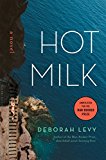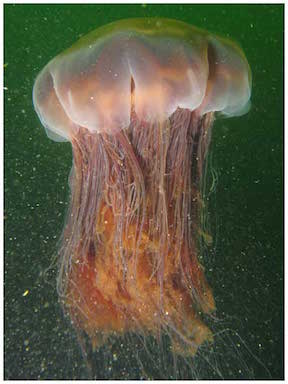Summary | Excerpt | Reviews | Beyond the Book | Read-Alikes | Genres & Themes | Author Bio

This article relates to Hot Milk
 In Deborah Levy's Hot Milk the main character, Sofia, spends time on the beach in Spain and is stung by jellyfish. The jellyfish, eerily beautiful yet often painful to humans, is one of a few creatures benefitting from global warming. Its numbers, which remained stable for a period, are now rising in many areas of the world.
In Deborah Levy's Hot Milk the main character, Sofia, spends time on the beach in Spain and is stung by jellyfish. The jellyfish, eerily beautiful yet often painful to humans, is one of a few creatures benefitting from global warming. Its numbers, which remained stable for a period, are now rising in many areas of the world.
Jellyfish have been around for over 500 million years. As they are not technically fish, many in the scientific community refer to othem as jellies and the two terms are used interchangeably. They vary greatly in size, most being less than half an inch wide to around 16 inches wide. They consist of 95% water. The jellyfish does not have blood or any solid skeletal structure; its body is divided into three main parts, the umbrella or core body (often bell shaped), the oral arms (around the mouth) and the stinging tentacles, which it uses to defend itself and also for propulsion. In place of a centralized brain it has a set of connected nerves.
 Jellies feed by first paralyzing their prey with a sting. Not all jelly stings can penetrate human skin. The effect of those that do ranges from mild redness and possible blistering, to death within a few minutes. For example, a sting from a box jellyfish (which, interestingly, hunts its prey, unlike most jellyfish who drift to it) will require a trip to the emergency room or may even kill you.
Jellies feed by first paralyzing their prey with a sting. Not all jelly stings can penetrate human skin. The effect of those that do ranges from mild redness and possible blistering, to death within a few minutes. For example, a sting from a box jellyfish (which, interestingly, hunts its prey, unlike most jellyfish who drift to it) will require a trip to the emergency room or may even kill you.
The Lion's Mane jellyfish, the largest known variety, grows to almost six feet wide; its tentacles can grow to more than 49 feet long. The Sea Mettle, another large jellyfish that lives in the Bering Sea, has tentacles that can stretch to 20 feet.
 Human-made stressors, including global warming, have produced a surplus of jellyfish in places such as Australia, Hawaii, the Mediterranean, and the Sea of Japan. At least in part this is believed to be because many of their predators have been overfished. According to scientists at the Smithsonian, increasing numbers of jellyfish – called "a jelly bloom" when grouped together – can disrupt the work of fisheries and may even disturb power plants' workings, clogging their cooling water. They can, of course, also can make swimming intolerable, and sometimes very risky.
Human-made stressors, including global warming, have produced a surplus of jellyfish in places such as Australia, Hawaii, the Mediterranean, and the Sea of Japan. At least in part this is believed to be because many of their predators have been overfished. According to scientists at the Smithsonian, increasing numbers of jellyfish – called "a jelly bloom" when grouped together – can disrupt the work of fisheries and may even disturb power plants' workings, clogging their cooling water. They can, of course, also can make swimming intolerable, and sometimes very risky.
Box Jellyfish
Lion's Mane jellyfish
Jellyfish bloom, courtesy of hepca.org
Filed under Nature and the Environment
![]() This "beyond the book article" relates to Hot Milk. It originally ran in August 2016 and has been updated for the
May 2017 paperback edition.
Go to magazine.
This "beyond the book article" relates to Hot Milk. It originally ran in August 2016 and has been updated for the
May 2017 paperback edition.
Go to magazine.
Use what talents you possess: The woods would be very silent if no birds sang there except those that sang best
Click Here to find out who said this, as well as discovering other famous literary quotes!
Your guide toexceptional books
BookBrowse seeks out and recommends the best in contemporary fiction and nonfiction—books that not only engage and entertain but also deepen our understanding of ourselves and the world around us.